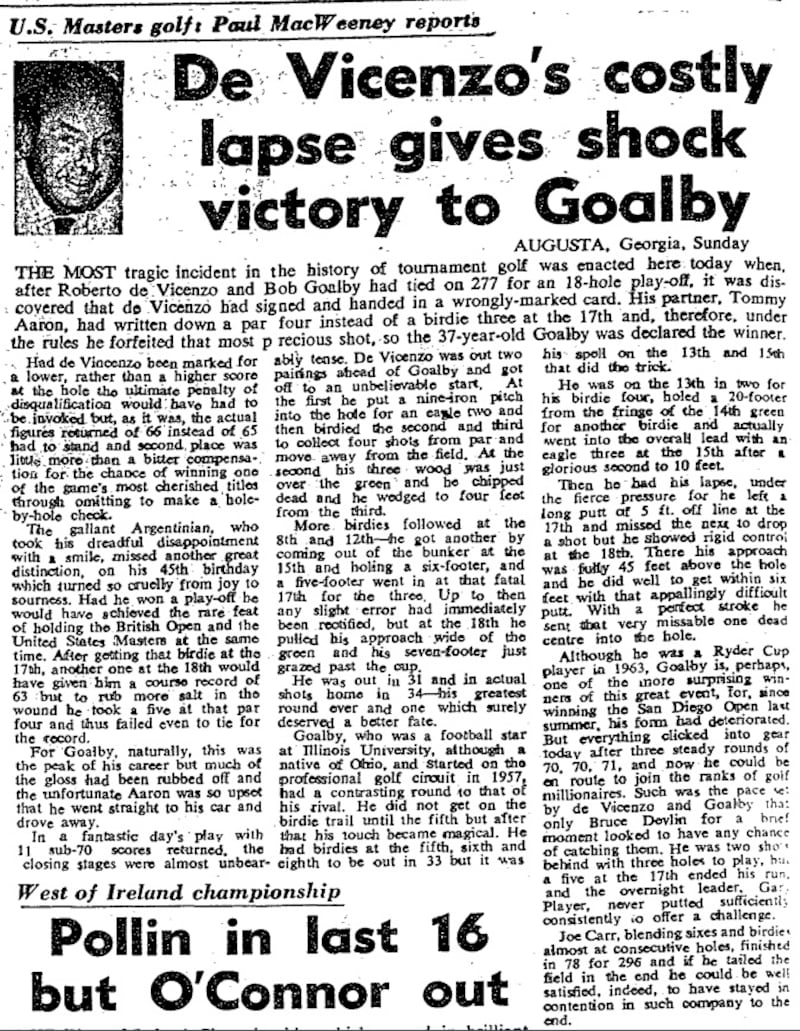Shortly after 5pm on Easter Sunday April 14th, 1968 Roberto De Vicenzo leaned back in his chair at the picnic table located behind the 18th green at Augusta National Golf Club and let out a sigh. His quest for a first green jacket had failed after a bogey five at the final hole, denying the Argentinean the greatest 45th birthday present of all. Little did he know that, at the same time, Bob Goalby was making bogey at the 17th meaning a Monday playoff would be needed to determine the Masters champion. Crucially though, he was unaware that the playoff in question would never take place because of a simple incorrect pencil mark on his scorecard.
At the same time, on the other side of the world, US troops were continuing to fight a war that they had already lost. The American death toll in Vietnam for 1968 alone stood at 5,507, bringing the total to 21,054 according to the front page of the Augusta Chronicle.
Just 10 days previous Martin Luther King – civil rights activist and hero of the largely black population of Augusta, Georgia who made up most of the contingent of caddies, ground staff and clubhouse workers at the still exclusively white golf club of Bobby Jones and Clifford Roberts – had been assassinated on the balcony of a hotel in Memphis, Tennessee.
Richard Nixon and Hubert Humphrey were locked in an ugly presidential election, Bobby Jones – founder of Augusta National and golfing pioneer – was confined to a bed in his cabin alongside the 10th hole, his body crippled by the syringomyelia which would eventually leave him paralysed and ensure that this was the last Masters he would ever attend.
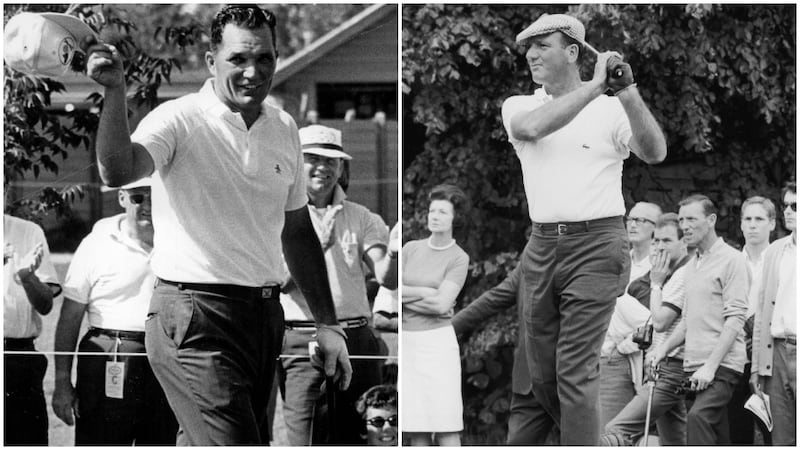
The American people needed an escape from the dark of everyday life and the Masters could provide that.
The 1968 tournament was set to be broadcast in colour for the very first time on CBS, giving the people a glimpse of the National's vivid tones of green grass, blue water, pink azaleas and white sand. The people needed an unforgettable Masters where the great triumvirate of the game – Arnold Palmer, Gary Player and Jack Nicklaus – would battle it out among the tall Georgian pines. What they got was certainly unforgettable, but not for the right reasons.
The first hope – that Palmer would claim a fifth green jacket – fell by the wayside before the weekend even started. The 38-year-old, playing alongside Ireland's Joe Carr, shot 72 and 79 to miss the cut. Carr, playing in his second Masters after he had become the first Irishman to grace the tournament the year before, made the weekend with rounds of 75 and 73, highlighted by birdies at the 16th and 17th on Friday to squeeze in.
At Augusta, Paul MacWeeney wrote for The Irish Times of the difficulties in partnering Palmer who commanded galleries so huge that they christened themselves ‘Arnie’s Army’.
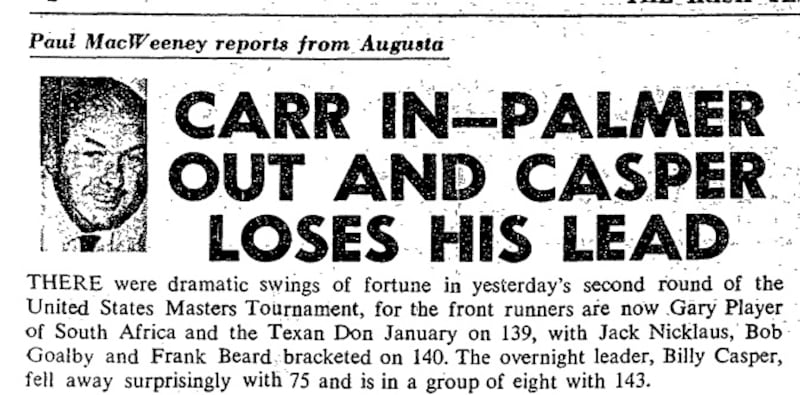
“Joe Carr achieved a magnificent feat for the second successive year of making the cut – with 75, 73 for 148 and it is just incredible to realise that he is in for the final 36 hole and Arnold Palmer is out,” MacWeeney wrote.
“Any of Palmer’s shots finishing on the green, no matter how far from the pin, is acclaimed, discrimination not being a feature of Arnie’s Army. So to partner him is the highest test of nerve.”
Dr King had been buried in Atlanta just two days before the Masters started, the war in Vietnam raged on and the subdued galleries – who MacWeeney reported had paid “a tidy twenty dollars for their four–day tickets” – would not have the golfing darling of Palmer to provide the thrills over the weekend. Another hero was needed. Step forward Roberto De Vicenzo.
A native of Ranelagh in Argentina – who passed away just last year at the age of 94 – was one of the game’s original global players. From Colombia to Spain and all over the world he amassed a total of 212 professional wins in his career, the biggest of which came at the British Open in 1967.
At a time when golfer’s earnings were a fraction of what they are today the burly Argentine – of much the same mould as Angel Cabrera – was happy to play anywhere he could to provide a living for his family back in South America. With his broken English, his beaming smile and flamboyant play – one feature was that he never used a tee for his opening shot of the day, preferring instead to get a feel for the ground by launching a driver directly off the turf – the Augusta galleries took him as one of their own in 1968.
Going into the final round on Sunday De Vicenzo was at four under par, two shots behind leader Gary Player, with five other competitors – including Goalby – at five under. Nine players were within two of the lead with 16 inside four shots. It was as close a Masters as anyone could ask for.

De Vicenzo had never been one to get too flustered about anything as he ambled around the course. What was about to unfold over the next few hours would change that, however.
After taking just six putts on the practice green as his warm-up, he clipped a 280-yard drive – directly off the ground – down the first fairway, leaving 120 yards to the green. From there he hit a soft nine-iron which landed on the green, bounced forward and dropped into the hole.
It was the start he couldn’t even have dreamed of. An eagle two and suddenly he was in a tie for the lead.
“He birdied the second and third to collect four shots from par and move away from the field,” MacWeeney wrote in The Irish Times.
“At the second his three wood was just over the green and he chipped dead and he wedged to four feet at the third.”
Further birdies followed at the Par 5 eighth and the famous Par 3 12th. Two groups behind Goalby had also started fast and the 1968 Masters was quickly becoming a two-horse race as the likes of Player, Nicklaus and Raymond Floyd failed to ignite on the final day.
After another birdie at the Par 5 15th, De Vicenzo led by one from Goalby and the back nine at Augusta drama was really coming to life.
After a lovely wedge shot to a few feet on the 17th, CBS encapsulated the drama by using the revolutionary medium of split screen to show Goalby’s putt for eagle at the same time. When both men found the hole for their respective threes, the simultaneous roars reverberated around the former cotton plantation, signalling that there was now a tie for the lead.
A par at the last and De Vicenzo would equal the course record and set a clubhouse lead of 12 under. But it was not to be as he failed to get up and down from left of the green, carding a bogey five and a 65.
Little did he know that, as he trudged off the green, Goalby was three-putting the 17th green to drop back to 11 under, alongside De Vicenzo.
Perhaps if the Argentine had been aware of this he wouldn’t have been in such a state of shock and disappointment when he sat down in front of Hiram C Allen Jr to check his scores and sign his card. Crucially however, he failed to do the first part of those duties. After quickly scanning his card, unable to take his eyes off the little number five that marked his score on the final hole, De Vicenzo signed the bottom of it and handed it to Allen. The damage was now done.
Had he looked more carefully at each score he would have noticed that his playing partner, Tommy Aaron, had inadvertently marked him in for a par four instead of a birdie three at the 17th. That all added up to a 66 and a total of 10 under par, not the 65 and 11 under which he had actually shot.
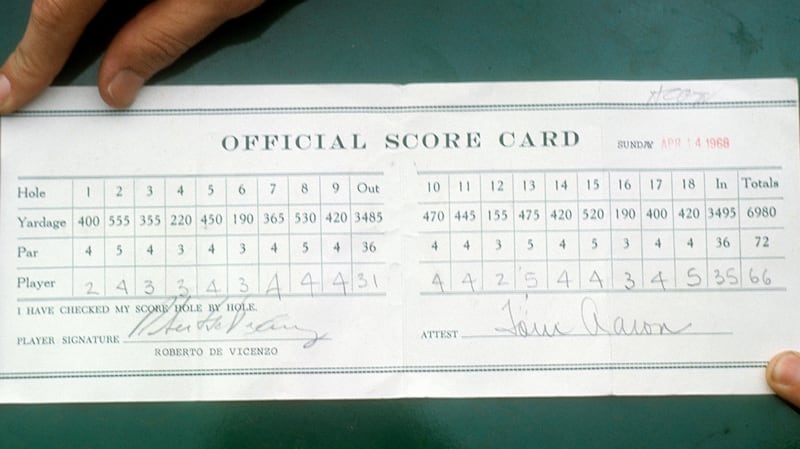
A green jacketed Augusta member swooped on De Vicenzo as soon as he had signed his card and whisked him off to the Butler Cabin for an interview with CBS. Just minutes later Aaron, who was studiously checking his own scores again and again, spotted the 66 which Allen had pencilled in as De Vicenzo’s total.
“Where’s Roberto?” he called. De Vicenzo was quickly sought out and brought back to the table. For 20 minutes or so there was utter confusion as the tournament organisers flustered and debated what to do.
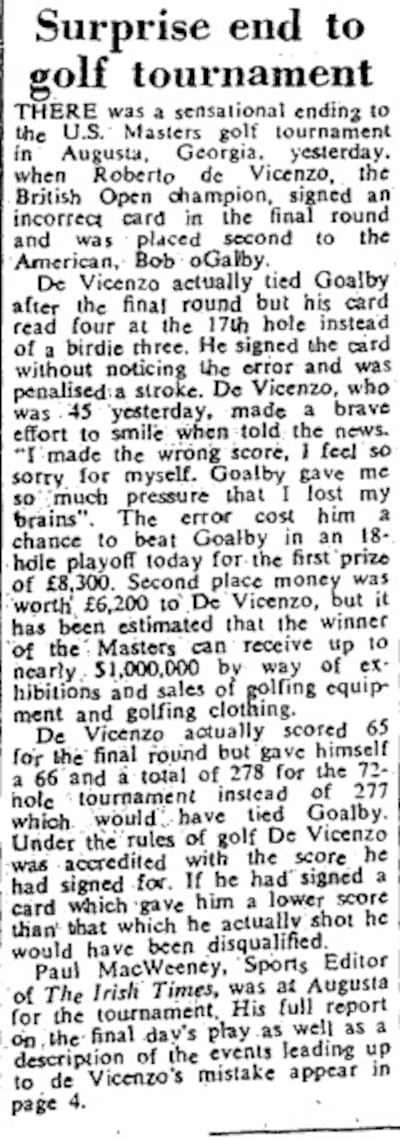
In that time Goably parred the last and shook De Vicenzo’s hand as the Argentinean remained seated at the picnic table in total shock at what was happening. Goalby didn’t know the mistake had been made and was already mentally preparing for a playoff. CBS announced broadcast details for Monday afternoon but then, shortly after doing so, commentator Pat Summerall told viewers to “stay tuned, there is a possibility we may have news of great importance.”
Clifford Roberts – co-founder of the National – had accompanied Allen and some other members to the bedroom of the stricken Bobby Jones to confer as to what they would do.
The decision was made that the rules of golf must be implemented: De Vicenzo had signed for a total of 10 under par and therefore finished 10 under par. Bob Goalby was the 1968 Masters champion.
“I am a professional for many years and I never think what a stupid I am,” De Vicenzo said at the awkward green jacket ceremony in the Butler Cabin afterwards. Goalby sat with his head in his hands, the unfortunate winner, while low amateur Vinny Giles looked like a lost schoolboy caught up in one of the biggest controversies ever to engulf the game of golf.
In The Irish Times the following day, MacWeeney wrote: “The gallant Argentinean, who took his dreadful disappointment with a smile, missed another great distinction, on his 45th birthday which turned so cruelly from joy to sourness. Had he won a play-off he would have achieved the rare feat of holding the British Open and the United States Masters at the same time.”
As for Goalby, the circumstances of his one and only major victory would follow him for the rest of his career. They say Americans love a winner but not this one. The following year the defending champion was booed by the galleries at Augusta - the unfortunate Masters winner in a year of American turmoil.
This is part of a monthly series called From The Back Pages examining stories and events that have made the sports pages of The Irish Times since 1859. If you have suggestions for stories you would like to see featured email rcroke@irishtimes.com or get in touch on Twitter @Ruaidhri_Croke. For more information on subscribing to the archive, see www.irishtimes.com/archive
